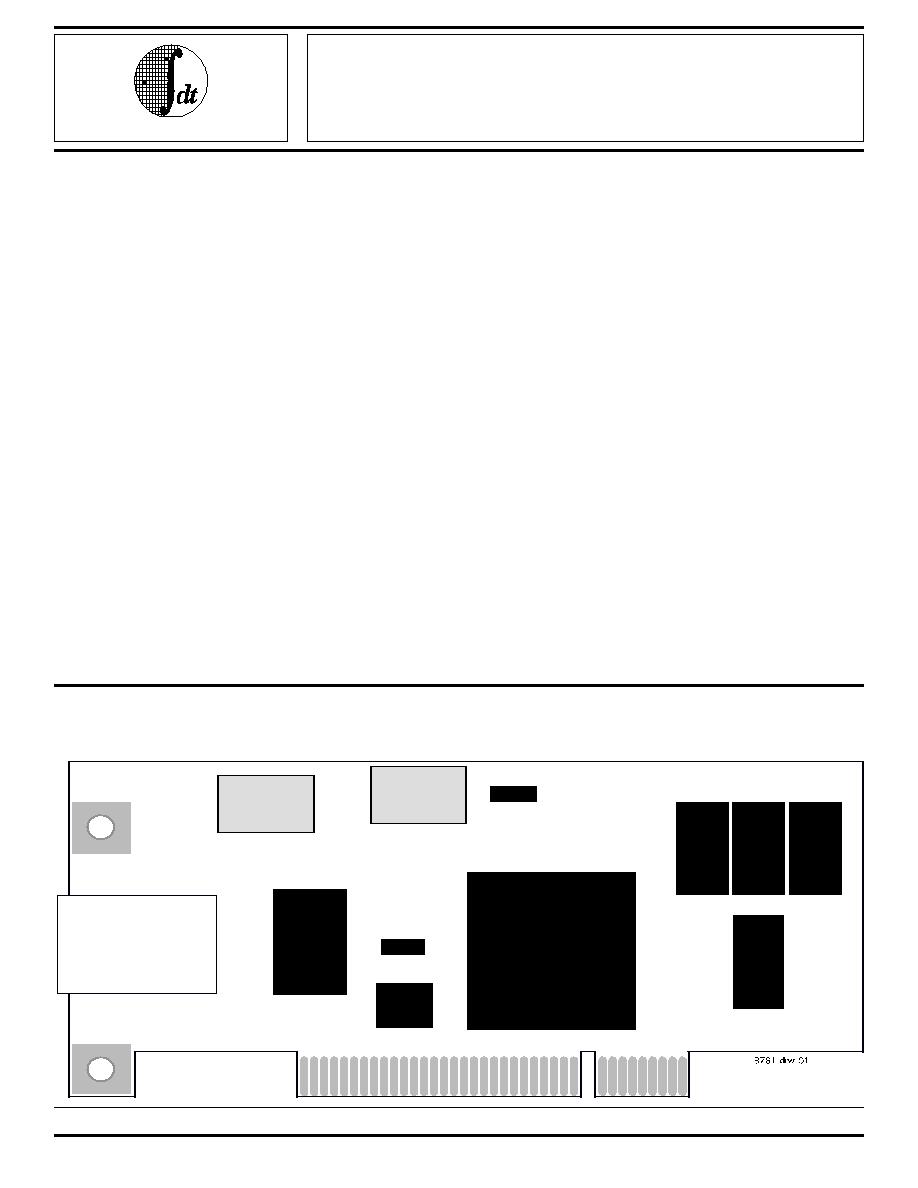 | –≠–ª–µ–∫—Ç—Ä–æ–Ω–Ω—ã–π –∫–æ–º–ø–æ–Ω–µ–Ω—Ç: IDT77914 | –°–∫–∞—á–∞—Ç—å:  PDF PDF  ZIP ZIP |

Integrated Device Technology, Inc.
Æ
COMMERCIAL TEMPERATURE RANGE
JANUARY 1997
©1996 Integrated Device Technology, Inc.
8.15
1
NICStARTM Reference Design
155Mbps Network Interface
Card (NIC)
ADVANCE INFORMATION
IDT77914
IDT77915
FUNCTIONAL BLOCK DIAGRAM
IDT
77211
SAR
E
2
PROM
32K
x8
SRAM
32K
x8
SRAM
32K
x8
SRAM
32K
x8
SRAM
50MHz
Osc
IDT
77155
PHY
ODL (77914)
or
RJ45 +
Magnetics
(77915)
19MHz
Osc
IDT74FCT
3384Q
PAL
FEATURES:
∑ Complete 155Mbps PCI-bus ATM Network Interface
Card
∑ Supports 33MHz, 32-bit PCI bus
∑ 155Mbps Multimode fiber optical interface (77914)
∑ 155Mbps UTP-5 PHY interface (77915)
∑ Complete reference design including schematics, bill of
materials, and data bases needed for production.
∑ Capable of supporting up to 16K receive connections
∑ Supports tens of thousands of transmit connections
∑ E
2
PROM layout for Sub-vendor ID
∑ Small Form Factor: 2.5 x 6 inches
∑ "SARWIN" software evaluation program available for
Windows 3.1TM
∑ Third Party Software available:
- Telogy Networks
Windows NTTM Drivers and other Windows Drivers
21 Firstfield Road, Gaithersburg, Maryland 20878
(301) 527-2788 (phone) (301) 417-0324 (FAX)
hluterman@telogy.com
- Harris & Jefferies
Novel NetwareTM Drivers
888 Washington Street, Dedham,
Massachusetts, 02026
(617) 329-3200 (phone) (617) 329-4148 (FAX)
chrisb@hjinc,com
- Advancenet Systems Inc.
Windows NTTM and Windows 95TM Drivers
406 Timbermill Rd., Durham, North Carolina 27713
(919) 544-5601 (phone) (919) 544-4601 (FAX)
j.harford@ieee.org or
75141,2635@compuserve.com
DESCRIPTION:
The IDT77914 and IDT77915 are designed to provide
stable reference platforms for evaluation, design, and produc-
tion of a 155Mbps NIC. The IDT77914 provides a fiber media
physical (PHY) interface; the 77915 supports Unshielded
Twisted Pair, Category 5 (UTP-5) cabling. Otherwise identi-
cal, they both feature complete PCI-bus ATM NIC functional-
ity, plugging directly into PCI bus expansion slots.
COMPATIBILITY AND CONFIGURATION
The board is designed for use in PCI systems, which may
include PC compatibles, MIPS, Alpha, Windows NT systems,
future PowerPC Macintosh systems, and so on. It supports
the 32 bit, 33 MHz, 5V part of the PCI spec, although this also
permits operation in a 64-bit, 33 MHz, 5V PCI slot.
OVERVIEW
The heart of the board is the IDT 77211 NICStARTM, which
is an ATM Segmentation And Reassembly (SAR) controller.
The NICStARTM connects directly to the PCI bus, a private

8.15
2
IDT77914/77915
ADVANCED INFORMATION
NICStARTM Reference Design
Commercial Temperature Range
SRAM/EPROM bus, and the Utopia PHY interface. The PHY
device is aIDT 77155 PHY. The PHY device connects in turn
to a Hewlett-Packard HFBR-5103 Optical Data Link (ODL)
device for the fiber optic connection (IDT77914), or to a Micro
Linear ML6672CH transciever for the UTP-5 connection
(IDT77915). The ODL incorporates its own fiber optic connec-
tors; the UTP option requires a line interface/filter transformer
and a standard RJ-45 jack.
THEORY OF OPERATION
The NICStARTM has 50 signal pins which connect directly
to the PCI bus edge connector. 32 of these are multiplexed
address/data signals, and the remainder are control signals.
The NICStARTM is compatible with the 5V, 33 MHz portion of
the PCI spec, so the eval board will work in motherboards with
32 or 64 bit, 5V, 33 MHz slots. The board will not work in 3.3V
slots.
The NICStARTM receives two clock input signals. One is
from the PCI bus, and this one can vary from DC to 33.333MHz.
The other is from a local oscillator on the 77914/5. The
NICStARTM's main clock is the SAR_CLK. It runs typically at
50 MHz. The rate of the Utopia interface, PHY_CLK is
connected to a devide by 2 output clock from the SAR.
Optionally, this clock can be supplied via a separate osallator,
the PHY clock, and runs typically at 25 MHz. All clock
oscillators on the board have ferrite-bead power supply filters,
and both SAR oscillator sockets have 33 Ohm source series
and 330/220 Ohm end parallel termination resistors provided
for optimum signal integrity.
The NICStARTM has a private local SRAM/EPROM data
bus, SR_I/O[31:0] and address bus, SR_A[16:0]. It also
supports a four-wire private EEPROM bus, three of which are
outputs (EE_SCLK, EE_CS#, EE_DO) and one of which is an
input (EE_DI).
NICStARTM supports 4 32Kx8 or 128Kx8 asynchronous
SRAMS. SRAM timing is fixed at one cycle. The NICStARTM
spec requires 20 ns access time SRAMs when the NICStARTM
is running at 50 MHz.
NICStARTM supports 1 32Kx8 or 128Kx8 EPROM. EPROM
timing is fixed at three cycles. NICStARTM requires a 70 ns
access time EPROM.
NICStARTM supports 1 EEPROM device. The four EEPROM
signals are completely under software control, so access
times and protocols can be specified by the user. The eval
board uses a Xicor X25020 EEPROM. This device requires
EE_CS# to be asserted low during all operations. Control or
data bits are taken from EE_DO at the rising edge of EE_SCLK,
and EE_DI changes on the falling edge of EE_SCLK. Refer to
the X25020 documentation for more information. The 77914/
5 provides LEDs on EE_DO (D6) and EE_SCLK (D5). These
LEDs illuminate when the corresponding signal is asserted
low, and may be used to signal status to the user when the
EEPROM is not being accessed.
The NICStARTM has a multiplexed utility bus, UTL_AD[7:0]
plus five UTL control signals. This bus may be used to
communicate with external 8-bit devices. The 77914/5 uses
the utility bus in this way to communicate with the registers on
the PHY. This interface is also under software control, so
protocol can be specified by the user.
FUNCTIONAL BLOCK DIAGRAM
5V 33-MHz 32-bit PCI Bus
RJ-45
Connector
and
Magnetics
IDT 77155
SwitchSTAR
PHY
IDT 77211
NICStAR
SAR
SRAM
50MHz
OSC
ATM Network
3761 drw 02
E
2
PROM
19MHz
OSC
Optial Data
Link (ODL)
Fiber Interface)
77914 only
77915 only

IDT77914/77915
ADVANCED INFORMATION
NICStARTM Reference Design
Commercial Temperature Range
8.15
3
The last two buses on the NICStARTM are the UTOPIA
transmit and receive buses. These follow the ATM Forum's
specification of the UTOPIA interface. They run at the PHY_CLK
speed, with the NICStARTM generating the TXCLK and RXCLK
signals to the PHY device.
The PHY device used is the IDT 77155. It has the standard
transmit and receive UTOPIA interfaces, and a non-multi-
plexed utility bus for register access. The PHY utility data bus
and address bus are connected together on the eval board;
the NICStARTM ALE signal defines the mode of this combined
bus in a way compatible with the NICStARTM and the 77155
SWITCHStARTM.
The 77155 reset input is driven by the NICStARTM's
PHY_RST# input. IDT's 77155 also provides an INT# output
which is connected to the NICStARTM's PHY_INT# input.
The 77155 transmit and receive clock reference frequency
is provided by a 19.44 MHz oscillator. This device is specified
at 10 ppm accuracy to meet the ATM Forum requirements for
155.52 Mbps operation. As with the other oscillators on the
eval board, this oscillator has a ferrite-bead power supply
filter, and a 33 Ohm source series termination resistor. End
termination is provided as part of a voltage divider network
designed to limit the input swing at the AC-coupled RRCLK
and TXCLK inputs on the 77155.
The 77155 has several control signals which are connected
to pullup and/or pulldown resistors on the eval board. Refer to
the 77155 documentation and the 77914/5 schematics for
more details. There are also several status outputs which are
not connected. One status output, RALM, goes high when any
of several different error conditions are detected by the PHY.
It is low only when a signal is present on the receive data
inputs, the 77155 is able to recover a valid clock from the
signal, and the data on the signal contains proper SONET OR
SDH frames. RALM is connected to an LED to act as a "link
detect" indicator.
77155 has a six-wire connection to the physical media
devices (PMD) which consists of three pairs of PECL-level
differential signals. One pair is transmit data, one pair is
receive data, and the last pair is signal detect, which can also
be connected as a single-ended PECL or CMOS signal. The
polarity of the connectors should be observed. The 77914/5
provides two PMD options (77914 and 77915), and includes
extensive termination circuitry with several possible configu-
rations to provide the best possible signal integrity between
the PHY and the PMD.
77914 Option
The 77914 interface is provided via a 9-pin fiber optical data
link (ODL) footprint which can be loaded with any standard 9-
pin ODL device. The 77914 is loaded with the Hewlett-
Packard HFBR-5103, which is a short-haul device for multi-
mode fiber, originally designed for FDDI. Other devices in the
HFBR-510x and -520x families should also work here, de-
pending on the application.
77915 Option
On the 77915 is a Micro Linear ML6672CH line interface
device intended for driving twisted-pair copper lines at high
data rates; it is characterized for 155 Mbps operation. Several
resistors and capacitors are provided on the 77915 to set
various line interface parameters on the ML6672CH. The line
interface side of the ML6672CH is connected to a Pulse
Engineering PE-68511 line interface transformer which is
designed for 155 Mbps operation over unshielded twisted pair
(UTP) cable. The connector used on the eval board is an
unshielded RJ-45 which must be low-profile to work in a
standard PC expansion slot. Unused pins on the RJ-45
connector go to a termination network to reduce crosstalk and
other forms of interference within the cable.

8.15
4
IDT77914/77915
ADVANCED INFORMATION
NICStARTM Reference Design
Commercial Temperature Range
ORDERING INFORMATION
ADVANCE INFORMATION DATASHEET: DEFINITION
"Advance Information" datasheets contain initial descriptions, subject to change, for products which are in development,
including features and block diagrams.
Datasheet Document History
8/22/96:
Initial Draft
Integrated Device Technology, Inc.
2975 Stender Way, Santa Clara, CA 95054-3090
Telephone: (408) 727-6116
FAX 408-492-8674
Integrated Device Technology, Inc. reserves the right to make changes to the specifications in this data sheet in order to improve design or performance and to supply the best possible product.
Package
IDT
NNNNN
Device Type
A
Power
NNN
Speed
A
A
Process/
Temp. Range
Blank
Blank
77914
77915
155Mb/s ATM Network Interface
Card (NIC) with Fiber Connection
155Mb/s ATM Network Interface
Card (NIC) with UTP5 Connection
Commercial
3761 drw 03
Blank
Blank
N
SAR



